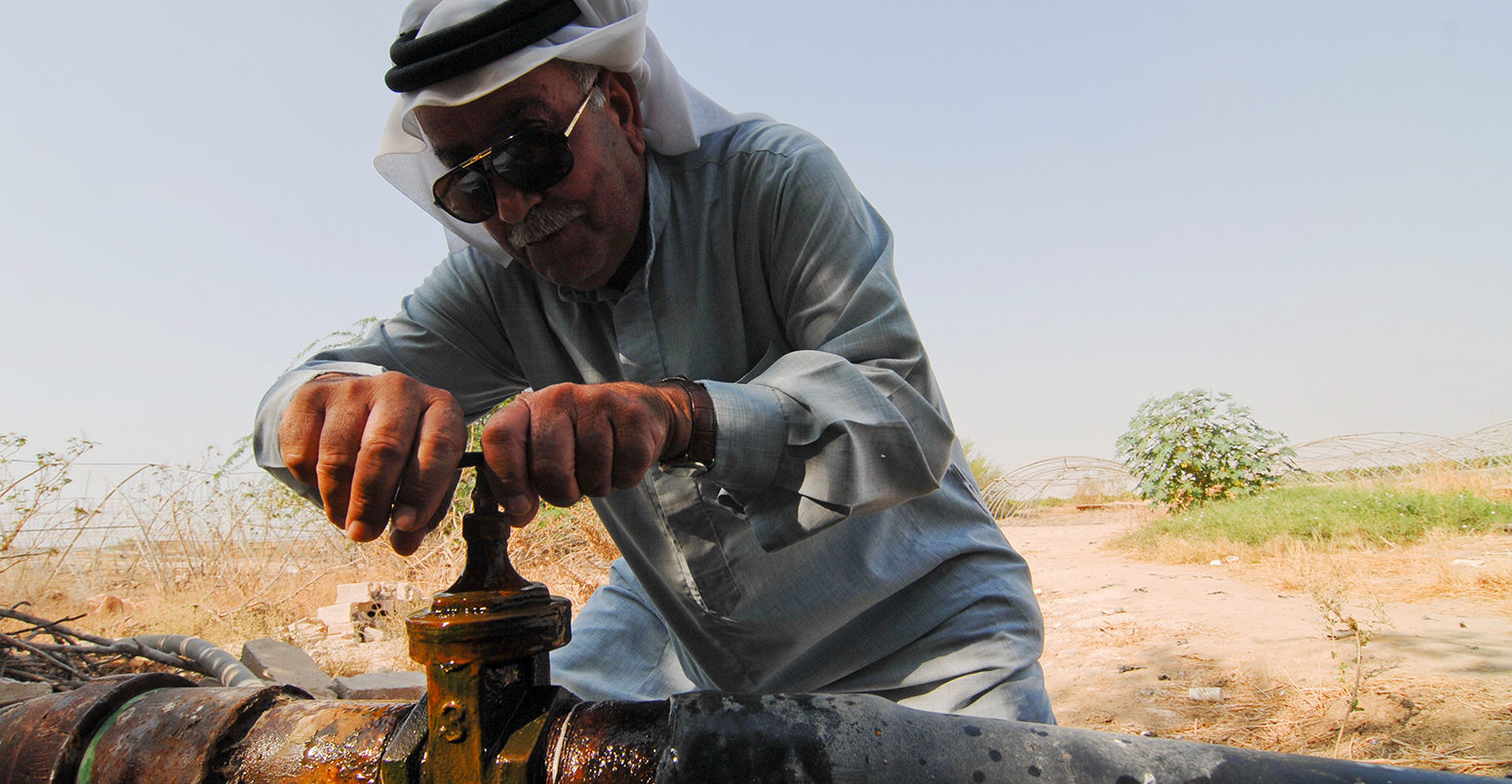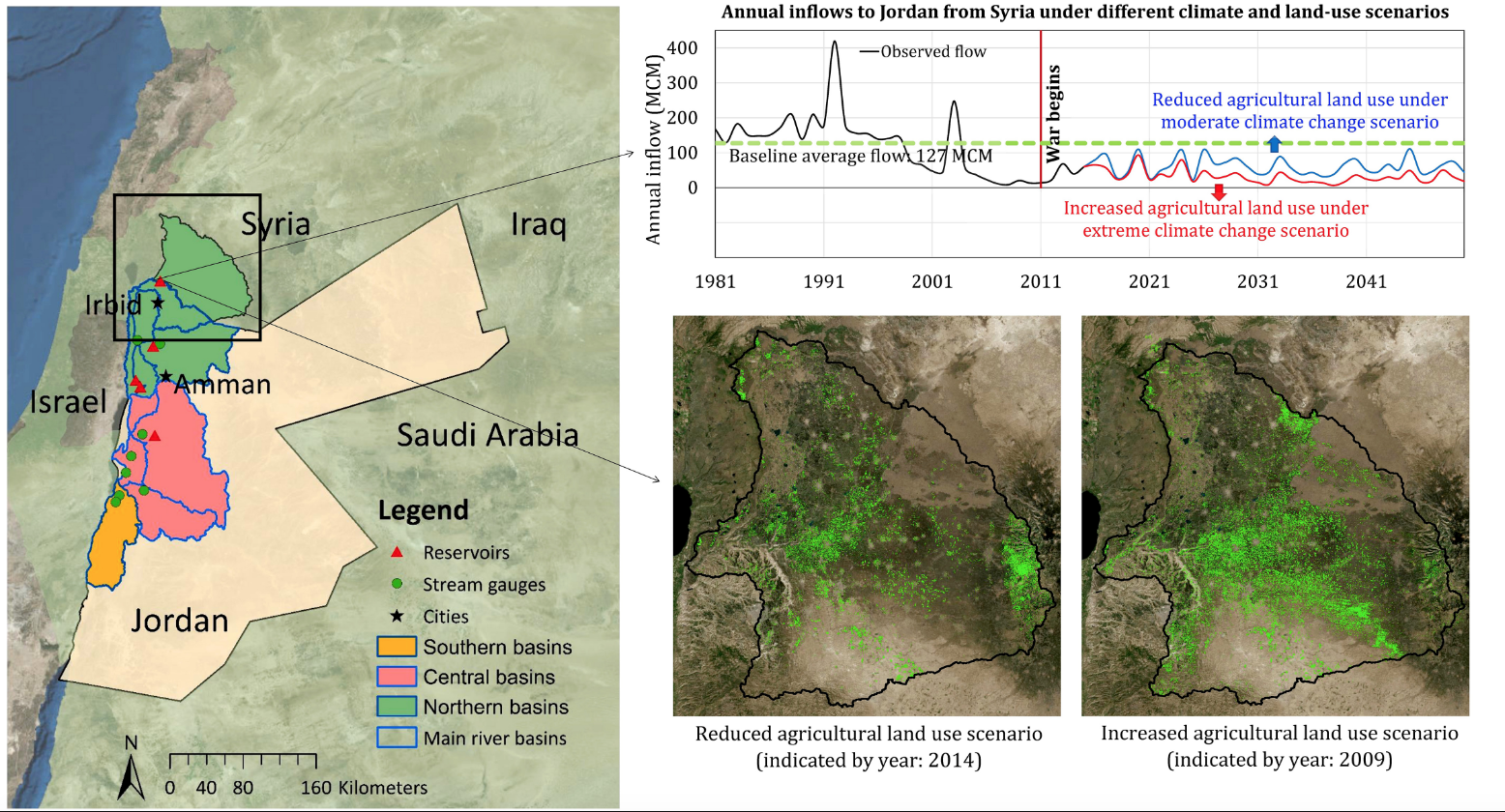
Climate change ‘could double’ the number of droughts in Jordan by 2100
Daisy Dunne
08.30.17Daisy Dunne
30.08.2017 | 7:00pmThe number of droughts in Jordan could double by 2100 as a result of climate change, new research suggests.
However, conflict in Syria, a close neighbour of Jordan, could also play a role in future drought risk in the region, the lead author tells Carbon Brief. An end to the Syrian conflict could see intensive farming return to the country, which could put further strain on shared water resources.
The research highlights the need to consider the complex interplay of climate change, agriculture and water sharing policies when estimating how warming will affect drought risk in water-stressed countries, another scientist tells Carbon Brief.
Jordan’s drying landscape
Jordan, a largely landlocked country in the Middle East, is the fourth driest country on Earth and one of the world’s most water-poor nations.
Its access to water has been restricted by a drying climate, as well as its downstream position in the Yarmouk-Jordan river system. Jordan shares these rivers with Syria and Israel so it is affected by how much water these other countries use upstream.
Adding to the demand for water resources has been the increase in Jordan’s population in recent years – in part down to receiving around a million refugees fleeing the Syrian civil war.
Overall, the freshwater available per person in Jordan has plummeted from 3.6m litres per year in 1946 to just 145,000 litres per year today, putting the nation far below the level of “absolute scarcity“, which is 500,000 litres per person per year.
This may sound like a lot, but it takes into account the water used in producing the food and other goods people use everyday. Water use in the UK, for example, is equivalent to more than 12m litres per person per year.
Despite its fragile state, little research has investigated how Jordan’s water security will fair in a warmer climate. The new study, published in Science Advances, says it aims to rectify that:
“Given the crucial role of Jordan in maintaining the stability of the Middle East and the threat to the nation’s water security, we present an analysis of the potential impacts of future droughts and climate change on the nation’s freshwater resources.”
A warmer world
Using regional climate simulations and hydrological models, the research finds that climate change could both increase the number and severity of droughts in Jordan during this century.
Under a scenario without global efforts to reduce greenhouse gas emissions (a scenario known as “RCP8.5”), Jordan could experience a 30% decline in winter rainfall and a 4.5C rise in annual average temperatures by 2017-2100, relative to 1981-2010, the paper says. Jordan receives the bulk of its rainfall during the winter season.
These changes could cause “meteorological” drought – a measure of low rainfall – to occur in 28 out of every 30 years by 2100, the researchers say. Currently, droughts occur in seven out of 30 years.
On top of becoming more frequent, droughts are also likely to become more severe, according to the research. It finds that by 2100, 15 out of every 30 years will experience extreme rainfall deficit, a precursor to severe drought. Such a severe deficit hasn’t been seen during 1981-2010, the researchers note.
Overall, the number and length of droughts in Jordan is likely to increase significantly, says lead author Dr Deepthi Rajsekhar, a researcher in water and soil science at Stanford University. She tells Carbon Brief:
“The duration and number of droughts could double by 2100, severely affecting river flows and agricultural demands. The severity of the droughts would also be significantly higher in future.”
The researchers also studied the effects of climate change under what they call an “optimistic” scenario where atmospheric concentrations of CO2 stabilise around the middle of this century (RCP4.5). Under this scenario, droughts are expected to become more frequent but not more severe, the research finds.
Syrian conflict
The ongoing risk of drought in Jordan will also be affected by how neighbouring countries use shared water resources, the researchers suggest. One of those countries is Syria, which has been mired in civil war since 2011.
(Carbon Brief has previously explored how a severe drought, made more likely by human-caused climate change, could have been one of the stressors behind the uprising that triggered the war.)
The map below (left) shows how Jordan’s northern water basin (green), which provides water to the country’s largest city Amman, straddles the border between southern Syria and northern Jordan.

Left: Map of Jordan with the major surface water basins colour-coded by region and the locations of the country’s major cities, reservoirs and stream gauges. Top right: Graph of changes to annual river flow into the Al-Wehda dam under different climate and conflict scenarios (indicated in red and blue). The dotted green line indicates the average annual inflow between 1981 and 2010. Bottom right: Map showing the amount of farmland in the Syrian portion of the Yarmouk basin before (right) and after (left) the Syrian conflict began. Source: Rajsekhar & Gorelick (2017).
This region of Jordan receives water from the Yarmouk River, the largest tributary of the Jordan River. River flow into Jordan from Syria is controlled by the Al-Wehda dam (marked on the map as the top red triangle) – Jordan’s largest reservoir.
Since the dam’s construction in 2005, the annual flow of water into the reservoir has been falling, further straining water supplies in Jordan. But water levels in the reservoir began rising again in 2013, the researchers say.
This partial recovery can be attributed to the Syrian conflict, which led to a sharp decline in water-intensive agriculture, previous research suggests. The map above (bottom right) shows the amount of farmland in the Syrian portion of the Yarmouk basin before (right) and after (left) the conflict began.
Drawing on this previous research, the researchers estimated how much water would flow into the reservoir, from Syria to Jordan, under different conflict and climate scenarios.
The graph above shows the water flow into Al-Wehda between 1981 and the beginning of the conflict in 2011 and future simulations of annual inflow under a range of scenarios. The dotted green line indicates the average annual inflow between 1981 and 2010.
The researchers produced “best-case” and “worst-case” scenarios of water availability in Jordan over the coming decades. These are shown as the blue and red lines on the chart above, respectively. The scenarios take into account both the extent of global action to limit climate change and the possible resolution of conflict in Syria. Rajsekhar explains:
“In terms of flows from Syria to Jordan, recovery of agriculture in the aftermath of the Syrian conflict would benefit Syria but it would further reduce river flow to Jordan and that would be in addition to the reduced flow to Jordan due to climate change.
“Should the Syrian conflict continue and the current state of agriculture maintained, the sole change in the flow to Jordan would be due to future droughts in Syria.”
This leads to the rather uncomfortable finding that the continuing conflict in Syria would actually give Jordan access to more freshwater. That’s not to say the researchers are advocating such a position though, Rajsekhar adds:
“Conflict is not a best case for anyone.”
Even under the “best-case” scenario, Jordan is still likely to experience 51% less inflow into the Al-Wehda dam in 2016-2050 – compared to 1981-2010 – because of climate change, the paper notes. Under the “worst-case” scenario, with uncurbed climate change and a return to pre-conflict levels of farming in Syria, inflow falls by 75% when compared to levels from 1981 and 2010.
Global implications
As well as drawing attention to drought risk in Jordan, the research sheds light on how climate change could affect relations between countries which depend on the same water sources, says Rajsekhar.
“Our approach is applicable to any region that is water-stressed due to a combination of climate change and unresolved regional or international water competition. There are 278 transboundary waterways that feed into shared watersheds occupying nearly half of the world’s land.”
The research also highlights that the future of water resources requires more than considering just the physical impacts of climate change, adds Dr Benjamin Cook, a researcher from the NASA Goddard Institute for Space Studies, who was not involved in the study. He tells Carbon Brief:
“The fact is, water resources are not evenly distributed and do not nicely follow political boundaries. This study is, I think, a nice contribution towards addressing this issue, highlighting the complex interplay of climate change, agriculture and policies.”
Rajsekhar, D. & Gorelick, S. M. (2017) Increasing drought in Jordan: Climate change and cascading Syrian land-use impacts on reducing transboundary flow, Science Advances, http://advances.sciencemag.org/content/3/8/e1700581
-
The number of droughts in Jordan could double by 2100 as a result of climate change

